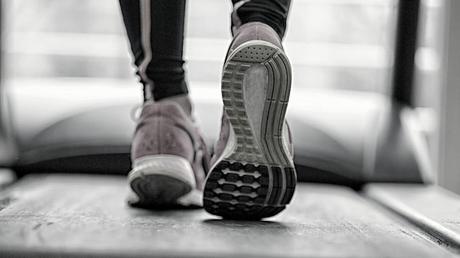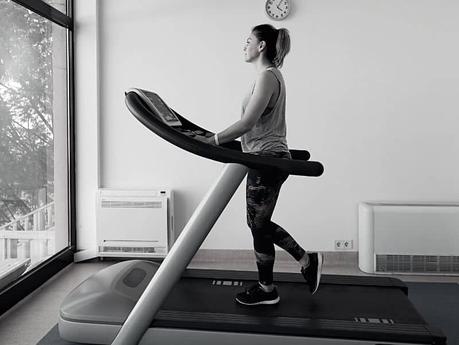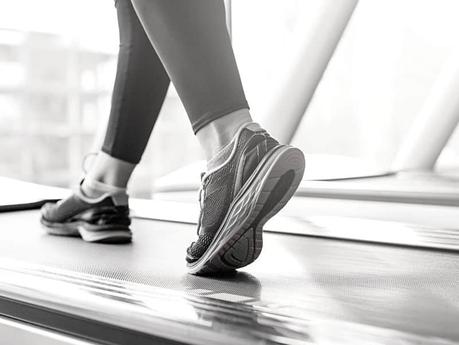
Walking on a treadmill is one of the best ways to lose weight, burn fat, and improve overall health. Here are nine benefits of treadmill walking and how long you should do it for optimal results.
When most people think about treadmill workouts for weight loss, their mind immediately heads for a treadmill run.
After all, the majority of us do our indoor runs on the treadmill when it’s too cold or rainy to run outdoors.
But the treadmill can be used for so much more than just running and jogging. In fact, it can be truly amazing for getting in a walking workout.
Below, were going to take a deep dive into the many, many benefits of treadmill walking, all the reasons that spending more time walking (not only running) is amazing for your health.
By the end of this post, I’m sure you’ll agree that walking on the treadmill can be a great way to get your daily workout and boost your current fitness routine.
Let’s jump right in.
Benefits of Treadmill Walking
 Benefit 1: Plenty of Calories Burned
Benefit 1: Plenty of Calories Burned

It’s true that the best way to burn a lot of calories on the treadmill is to jog, run, or sprint.
If you look at the number of calories burned on the treadmill by various exercises, you really only get into the big numbers when you pick up the speed.
According to data collected by Harvard Medical School:
- A 125-pound person will burn 107 calories in 30 minutes of walking at the average pace (3.5 MPH)
- A 155-pound person will burn 133 calories in 30 minutes of walking at the average pace (3.5 MPH)
- A 185-pound person will burn 159 calories in 30 minutes of walking at the average pace (3.5 MPH)
That’s not a whole lot, is it? Compare that to a faster-speed workout:
- A 125-pound person will burn 240 calories in 30 minutes of a 5 MPH run
- A 155-pound person will burn 288 calories in 30 minutes of a 5 MPH run
- A 185-pound person will burn 336 calories in 30 minutes of a 5 MPH run
- A 125-pound person will burn 375 calories in 30 minutes of a 7.5 MPH run
- A 155-pound person will burn 450 calories in 30 minutes of a 7.5 MPH run
- A 185-pound person will burn 525 calories in 30 minutes of a 7.5 MPH run
As you can clearly see, the faster you run, the more calories you burn.
But what you need to remember is that you can only run for so long.
Advanced runners, like marathoners and ultra marathoners, can run for hours and burn thousands of calories in a single day. Intermediate-level trainees will be able to push their pace of 45 or even 60 minutes.
The average newbie, however, may only be able to run for 15, 20, or even 30 minutes.
Fun Fact: By adding incline on the treadmill machine you can significantly increase calorie burning. One study2 found that people burned up to 60% more calories when using incline compared to walking on flat ground.
On the other hand, you can literally walk for hours without tiring. Hikers may be able to sustain a moderate hiking speed (3.5 MPH) for up to 6 to 8 hours, and even casual strollers should have no trouble managing 2-3 hours at a slower walking pace on flat terrain.
If you do the math, you’ll see that a long-distance, multi-hour hike or walk will actually burn a lot more calories than a 45-to-60-minute run.
Even if you’re not hiking, but you’re only strolling around town, along the boardwalk, through a lovely park, or on the treadmill (while watching a TV show or movie), sustained movement for more than a couple of hours can burn quite a number of calories.

 Benefit 2: Walk Anytime
Benefit 2: Walk Anytime

One of the best treadmill benefits is that there is no need to worry about the weather.
It could be spitting rain, snowing heavily, or hailing up a storm, and you’ll still be able to get in a great workout.
Because you are indoors, where the climate and temperature are fully controlled, you can literally walk at any time of day or night.
For those of us who lead busy lives and have a hard time fitting in a gym workout during the day, early in the morning or late at night may be our only times to train. A treadmill just makes it easier to walk anytime, even if it’s dark or cold out.
 Benefit 3: Walk More
Benefit 3: Walk More

Most of us can sustain a decent walking pace for up to an hour. Any more than that, and will start to feel the fatigue, need a drink of water, need a snack, etc.
But, as with any other type of activity, you can train yourself to walk more. You can push your average walk time from 30 or 45 minutes to 60 minutes, 90 minutes, or even 2 to 3 hours.
Because you are in a climate-controlled environment with a machine that lets you control your terrain (flat level or incline as desired), you can make your walk as easy or difficult as you want.
Thanks to the fact that you can walk daily, it will be easy to push your walk time and distance. A 10-mile walk may feel difficult now, but give it a few weeks of daily 10-mile walks, and suddenly you’ll have no trouble walking 15 to 20 miles because you are accustomed to walking more.
 Benefit 4: Train Yourself to Walk Faster
Benefit 4: Train Yourself to Walk Faster

Just as you train yourself to run faster using the treadmill (with speed that you can control), you can train yourself to walk faster on the treadmill.
The average person walks at a speed of roughly 3.5 MPH. To walk faster, all you have to do is press the button to speed up your pace slightly. For the first week, you can walk at 3.6 MPH.
Fun Fact: Walking (or running) on a curved treadmill is a way to burn more calories and also increase cadence. One of the main benefits of curved treadmills is that they are more joint-friendly thanks to the upward curve of the machines.
The second week, push yourself to 3.7 or 3.8 MPH. By the end of the first month, you could be easily walking at 4 MPH.
It will take some time to get accustomed to a faster walk speed, but thanks to the treadmill’s motorized controls, you can easily set your desired pace and push yourself to walk faster every single workout.
 Benefit 5: Improve Your Cardiovascular Health
Benefit 5: Improve Your Cardiovascular Health

No matter what types of treadmills you use, the benefits are the same.
Walking does wonders for your cardiovascular system. Research has identified a number of heart-smart, cardiovascular-boosting effects of walking, be it on the treadmill or outdoors:
- Eliminate the triglycerides, fats, and cholesterol that could clog up your arteries.
- Lower your risk of Type 2 diabetes.
- Protect your heart against stroke and heart attack.
- Lower your blood pressure.
- Improve cardiovascular fitness, enabling your heart to beat more efficiently, your lungs to absorb oxygen into your bloodstream, and your blood vessels to dilate effectively so oxygenated blood can get where it needs to go.
Faster, more frequent walks will have a direct positive impact on your cardiovascular health.
 Benefit 6: Improve Your Mood and Endocrine Balance
Benefit 6: Improve Your Mood and Endocrine Balance

There is a lot of research that links daily exercise to improvements in both your mood and your hormone balance.
Exercise produces a flood of adrenaline, dopamine, serotonin, and other feel-good chemicals that will elevate your mood and decrease your feelings of stress. That’s why you always walk out of the gym or finish your home workout feeling so good, even if you were anxious, nervous, worried, stressed, or grumpy before starting.

Exercise also triggers the release of critical hormones, including testosterone, growth hormone, insulin-like growth factor, brain-derived neurotrophic factor, and insulin. All these play central roles in maintaining your health!
 Benefit 7: Improve Bone and Joint Health
Benefit 7: Improve Bone and Joint Health

One great thing about walking is that it is amazing for your skeletomuscular system!
Every time you take a step forward, your joints engage to move your limbs smoothly. The more you move, the more mobile your joints will remain. Even as you age, walking will help to maintain your mobility and flexibility, so you will be less likely to suffer mobility issues and stiffness (a common side effect of aging, especially in sedentary people).
Your bones also grow stronger because of walking. The light impact of walking will cause microscopic damage to the bone tissue. Your body will repair that damage and strengthen the bone tissue, so it’s more resilient against future damage. Over time, the continual damage-and-repair cycle leads to much stronger bones.
Walking isn’t a very high-impact exercise, however, so it’s safe for people with joint problems or weak bones. It’s a highly effective means of strengthening the skeletal system with a very low risk of injury, but a very high rate of improvement.
 Benefit 8: Improve Digestion
Benefit 8: Improve Digestion

Did you know that walking after your meals is a great way to speed up digestion?
For thousands of years, people have gone for “post-prandial strolls”, gentle walks immediately following a meal.
Walking encourages the muscles in your stomach and intestines to push the food farther along the digestive tract. It encourages stomach-emptying, ensuring that the food gets to the small intestines to be more efficiently broken down and absorbed into your bloodstream.
From there, it sends the food to your large intestines, where it’s further broken down by gut bacteria and either absorbed or eliminated.
But that’s not all!
Walking also prevents blood sugar spikes. Research has shown that even 15 minutes of walking within 60 to 90 minutes after a meal causes the body to utilize the blood sugar currently stored in the muscles, bloodstream, and liver.
This essentially makes “space” for the new glucose being absorbed from the food you eat, allowing your muscles to absorb that sugar and stopping it from causing a spike in your blood sugar levels.
 Benefit 9: Structure Your Workouts
Benefit 9: Structure Your Workouts

Last, but certainly not least, indoor treadmill walking gives you an easy way to structure your workouts.
When you’re walking outdoors, you have to walk according to the terrain (up or down hills). You have to stop for stoplights and navigate crowds at a slower speed. You have to follow the flow of traffic or take unforeseen detours. It’s more challenging to sustain a consistent speed for all these reasons.
But when walking indoors, all you have to do is set the treadmill to your desired speed and you’re good to go for the entire workout. The motor will keep spinning at the speed you set it to and will never slow down unless you want it to.
If you want to tackle some hills, you can raise the incline as desired. If you want to take it easy, you can keep it at a flat level. You can switch it up and mix-and-match to give yourself a varied workout, too.
Essentially, you have total control over every aspect of your workouts when on the treadmill. You can set a desired walk time, a desired distance, or even a desired heart rate or calorie-burning goal.
For those who are training a very specific way, or who are working towards a very specific goal, training on a treadmill may be the best choice for getting a fully structured, controlled workout.
Treadmill Walking – FAQs
What are the differences between walking on a treadmill and walking outdoors?
Some of the biggest differences between walking on a treadmill and walking outdoors include:
- Controlled vs. uncontrolled environment.
- Predictable vs. unpredictable terrain.
- Sustainable vs. variable speed.
- Exposure to weather vs. regulated indoor conditions.
While walking outdoors is typically the preference for many people, there are a lot of great reasons to walk on a treadmill indoors.
How long should you walk on the treadmill to see results?
Walking for anything less than one hour will not burn enough calories for you to see real fat-burning results. Your body takes time to activate stored fat to burn for energy, and because you’re working at low intensity, you will only burn small amounts of calories with your walking.
So you have to walk a lot more in order to burn the kind of calories you want to burn to lose weight.
However, if you don’t have an hour or more, it still worth spending 20 to 45 minutes on the treadmill every day. You can improve your mobility, stretch your sore and tired muscles, facilitate active recovery, and get in at least some activity.
If you can’t get any other type of workout in, and you have only a short window to do some sort of movement, it’s worth putting in those few minutes.

Can you walk on a treadmill daily?
Not only can you walk on a treadmill daily, you should walk on a treadmill daily!
Walking is amazing exercise that offers a lot of benefits (as you’ve seen above). You can fit a walk alongside literally any other workout without pushing your body to the point of exhaustion or injury.
Because it’s low-impact and low-intensity, you can also do it daily without the need for recovery between workouts (like you need to with weightlifting, running and other high-impact, high-intensity forms of exercise).
Walking is great for active recovery, serves as an excellent cooldown following any resistance training or cardio workout, and will aid in digestion, mood, bone and joint health, and cardiovascular health.
You should make it a goal to walk at least 20 to 30 minutes a day on top of your other workouts. If walking is your only workout for the day, shoot for 90 to 120 minutes of walking.
The Bottom Line
Walking may not be the most efficient calorie-burning exercise, but it’s still a great way to get some activity in on a day when you’re just not feeling up to running, lifting, or doing some other hard-core, high-intensity exercise.
A good walk can still burn fat, promote muscle recovery, get your metabolism working, and make you feel better.
With the treadmill, you can walk anytime, no matter the weather, and train yourself to be a more efficient, faster-paced walker in real life conditions.
That’s a benefit that’s absolutely worth the time invested in your treadmill workouts!
More Treadmill Guides and Articles
Manual vs. Motorized Treadmills: Which is Best for Your Goals? Wondering whether a manual or motorized treadmill is best for you? Below, we highlight the differences between the two so that you can choose the right treadmill for your running goals.
